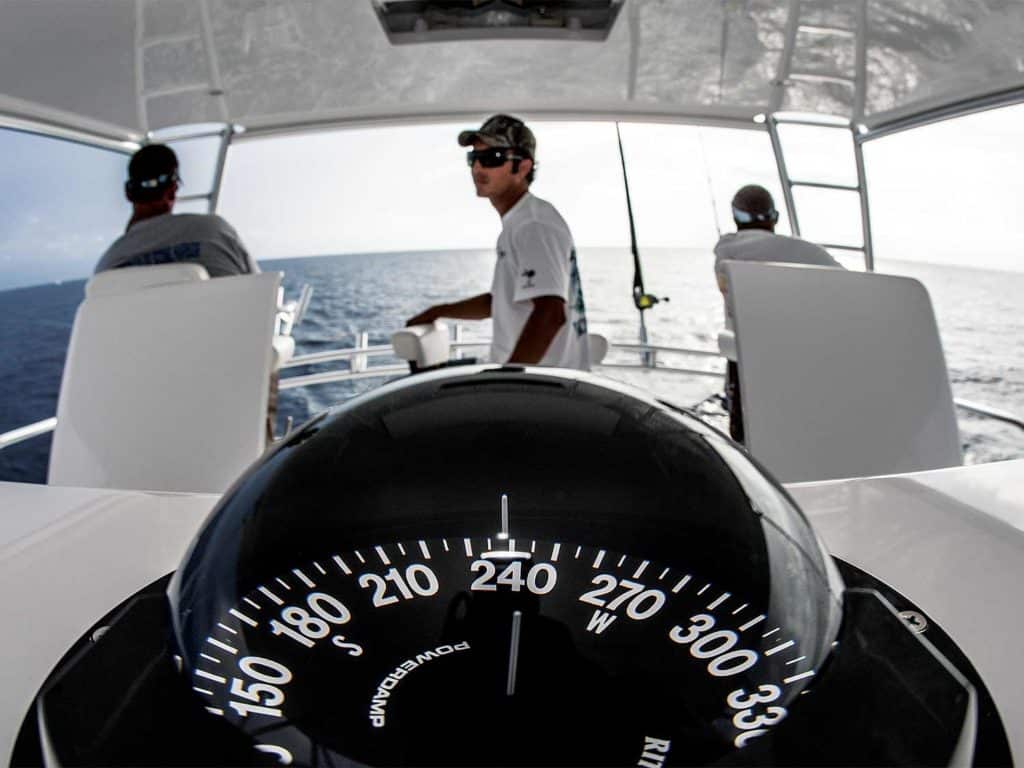
Our planet’s northern magnetic pole is not only racing toward Siberia at about 34 miles per year, it has been to Antarctica several times in the last million years—and it’s due to flip again. This isn’t new to old-school mariners, but the concept is probably not so familiar to younger captains who are accustomed to GPS.
Increasingly, the compass is ignored, much like a dictionary on a bookshelf: one an ornament, the other a doorstop. And the Earth’s fickle magnetic force seems to further diminish its standing.
Not so fast. “If you are in the Arctic Circle and the pole moves 30 miles, the difference can be significant,” says Patrick Lonergan, technical services manager in engineering and quality control for Ritchie Navigation. “But in the lower 48 states, most mariners wouldn’t notice the variation between magnetic north and true north.”
James McGowan, marketing director for Raymarine, agrees, to a—ahem—degree. “By default, GPS systems report position and headings based on true north,” he says. “You can set it to report magnetic headings, but most navigators don’t even consider the nuances of compass navigation using GPS.”
Every five years, the National Oceanic and Atmospheric Administration issues new compass-variation figures based on the current location of the magnetic North Pole; the last update was 2018. Your GPS maker then issues a firmware update with the new figures, so when you do call on GPS for a magnetic heading, it automatically calculates the heading based on the magnetic variation at your location. However, for the past two years the pole has drifted so far, so quickly, it is likely NOAA will issue an early update in 2020.
But relax and don’t worry about the Earth tumbling ass over teakettle and don’t toss out your compass, because the farther you navigate from the magnetic North Pole, the smaller the variation between true and magnetic north. The variation is easy to add to your steering heading, and in the world of global positioning, your compass has a different role in partnership with a GPS.
“We consider the compass a steering device,” Lonergan says. “It’s not as easy to steer to a GPS heading.” He’s right.
Here’s why: Unless your GPS is equipped with a fluxgate compass, which is an electronic version of a magnetic compass that is likely in your autopilot, it’s calculating your heading on the chart plotter by projecting a line through your past positions.
It works fairly well at a high speed but less so at slower speeds. So, experienced navigators steer by compass using the magnetic heading computed by the GPS. You can set that heading in a data window on most chart plotters. The magnetic heading is calculated to take the local variation into consideration.
With your GPS-adjusted compass heading, there is still one more adjustment you need to make. Your boat’s compass could be off by several degrees because of magnetic forces in the boat. That compass deviation, as it’s called, might be, say zero to 20 degrees.
If your compass is already installed, navigating a known northerly heading as determined on a chart can tip you off to the amount of deviation. Adjustment screws can remove up to 20 degrees of compass deviation. You’ll need to do the same thing with an east or westerly course.
Learn to use radar to find birds (and better fishing)
So, if you want a true heading of 90 degrees, your GPS will report a compass heading of 96 degrees—the compass-card reading, plus the magnetic variation. If the compass’s magnetic deviation is also 5 degrees west, you’ll add another 5 degrees—if you haven’t adjusted your compass—and you’ll steer to 101 degrees. If you are returning to Cape Canaveral, Florida, from 30 miles out, failing to note the deviation and variation won’t be the end of the world—you’ll get close enough. But if you were boating in the Chukchi Sea near Kotzebue, Alaska, that variation would be in the teens—and it might kill you.
The bottom line: Don’t dismiss your compass, because using it properly means letting your GPS navigate while you steer by the compass. And don’t worry about our defecting magnetic North Pole, even if it makes it to Siberia—NOAA has your back.







